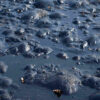Shrimp Feed Additive
Conservation of marine life is too necessary, as it provides 20% of animal protein to about 3 billion people worldwide. Along with this, more than 50 million people are relying on the fisheries and aquaculture sector for their living. Hence, more sustainable and responsible fisheries and aquaculture solutions are vital for saving the life below water.Shrimp Digestive System
Shrimp feed by grazing the bottom of the pond for substrates. Their high exposure to the exchange of microflora between the environment and their digestive system enhances the risk for the proliferation of unfavorable gut microflora. This can disturb the functioning of their digestive system.
The digestive system of shrimp is the main entry point for bacterial and viral infections. Therefore, there remains a risk for profitable shrimp production. Using antibiotics to control microbial growth during the production process is not appropriate due to the high risk of building up resistance and the industry shift towards antibiotic free products.
Shrimp Feed Behavior
Shrimps are slow feeders. Finding the prime way to feed shrimp can make or break profitable farming. Moreover, understanding the fundamentals of shrimp behavior is important for feeding practices.
Shrimp start exploring, crawling, and using chemoreceptors to find feed across long distances. When they detect their food with chemoreceptors, they begin to orient themselves towards the food. Now you can observe their antennule flicking behavior.
Like many other animals, shrimp also start grooming after feeding. They have clear feed rejection patterns. For instance, they can move around the food without interaction.
Furthermore, when they eat food, no mouth movements are observed. Hence, they are called creatures of habit and can familiarize themselves with a particular feeding area.
Shrimp Feed Additives
Some alternative methods are required for the shrimp industry to control the microbial ecosystems in the production system. Sustainable methodologies are necessary to overcome the gut microflora in shrimp, including the use of natural compounds. These compounds should be capable of modulating the microflora toward profitable composition, such as probiotics, organic acids, yeast extracts, and probiotics.
Probiotics used as Shrimp Feeds Additives
Microbes play a dominant role in producing shrimp feed additives. Hence, Bacillus subtilis is a microbe used as a shrimp feed additive. B. subtilis consumption in shrimp and aquaculture can enhance feed digestion and integration, improve water bio remediation, and prevent disease growth.
Bacillus subtilis applications as a probiotic bring promising results for aquaculture growth. B. subtilis is a non-pathogenic gram-positive spore-forming bacterium used to improve the growing concern in shrimp health and disease control.
Benefits of probiotics as Shrimps Feed Additives
Safer, sustainable, and eco-friendly solutions.
Boosts immune activities and protects the body from pathogens.
They are growth promoters.
Improve quality products.
Control the diseases and enhance immunity in shrimps.



